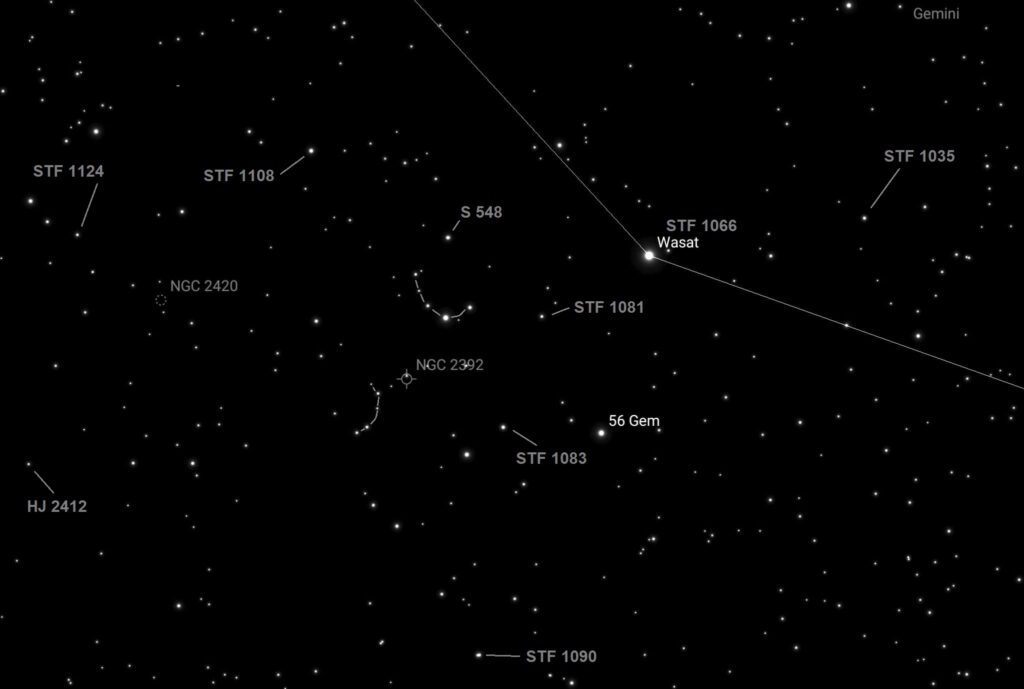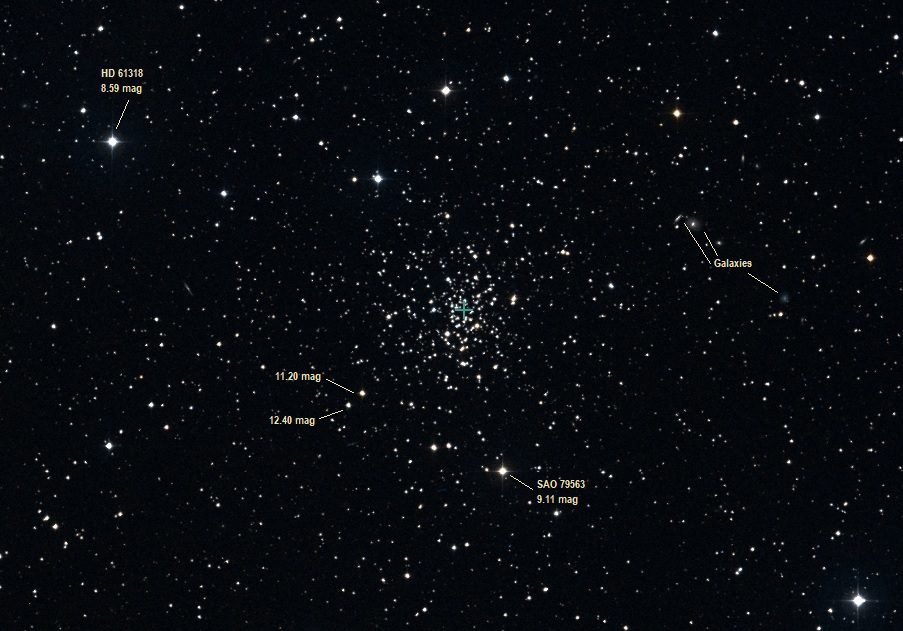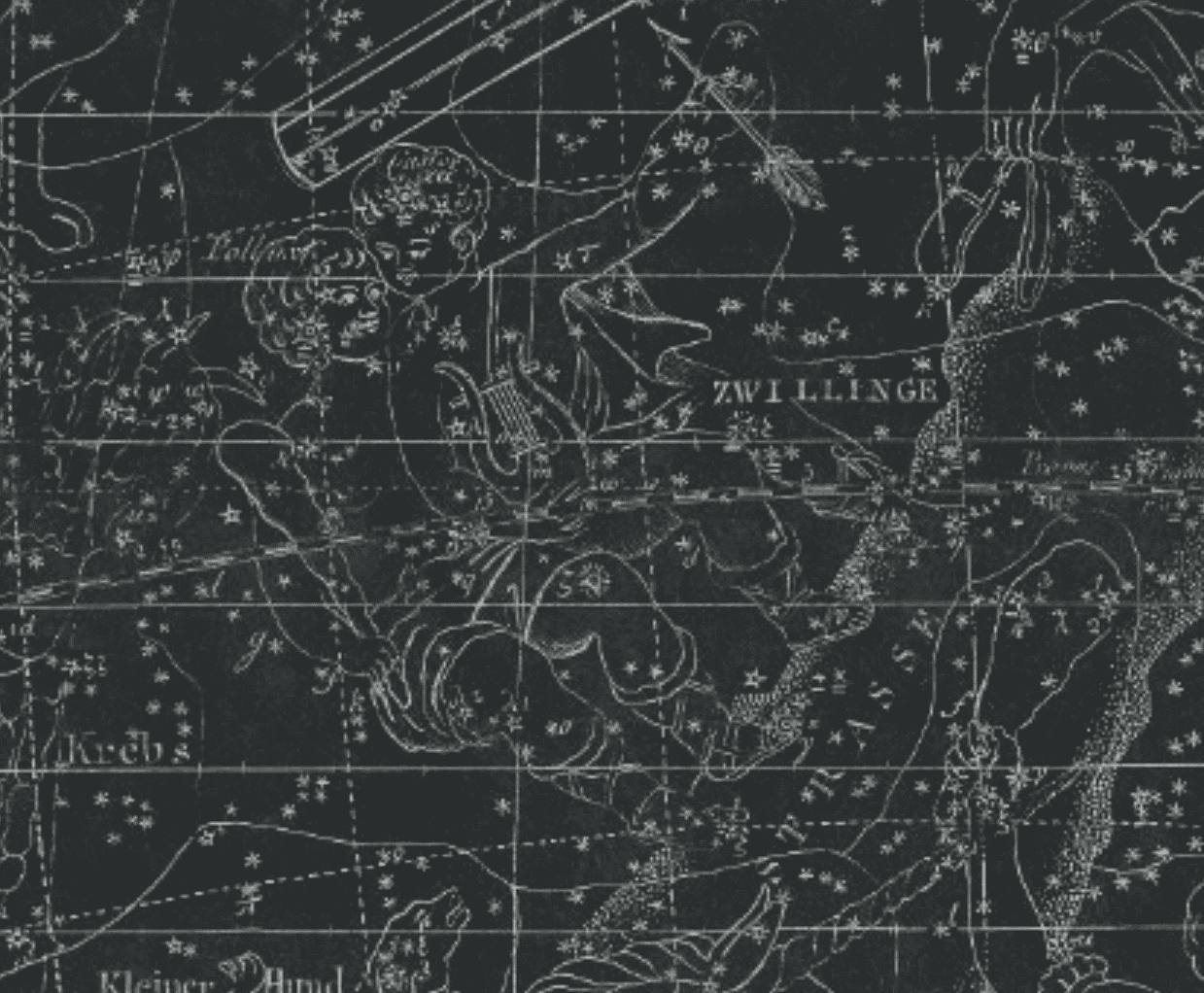The starfield around the star Wasat in the constellation Gemini (also named Delta Geminorum, 55 Gem, STF 1066) first attracted my notice years ago because of its marque denizen, the planetary nebula, NGC 2392 (the Eskimo Nebula) which is a fine object for high magnification telescopic views, but also enjoyable with larger binoculars or with binocular telescopes.
For many years, my views of this star field were more or less confined to the finder scope while locating the Eskimo nebula, but having seen the binocular astronomy light I now find much more to enjoy here.

NGC 2392 / Eskimo Nebula
Discovered on January 17, 1787 by William Herschel, the distance to this planetary nebula is estimated at 5983 light years (Gaia Early Data Release 3, 2020). It appears as a swollen non-stellar disc with a pleasingly blue tint viewed with binocular telescopes at 32x. From my suburban yard it can be seen with 20x binoculars but looks mostly stellar on the average night. Higher magnification with larger binocular telescopes (100XL-SD or 127XL-SD 56-80x) reveals a compact inner core and the 10.5 magnitude central star.
Wasat / STF 1066
3.55/8.18 sep 5.5″ pa 229*
The seventh brightest star in Gemini. Its name comes from the Arabic word for “middle,” the reference to which is uncertain. It is 59 light years distant, and an F0 IV subgiant in the first stages of becoming a giant star whose central hydrogen fusion has ended. It is ten times brighter than our sun. It might be possible for me to resolve Wasat with the 127XL at higher magnifications than I typically use with BTs – 92x (7mm XWs) or even 130x (5mm XWs) – on a night of ideal seeing (which are rare here in the spring months). But a much easier option (and what I actually did on Thursday evening, 6 April 2023) is to observe it at 172x with an Orion CC8 Classical Cassegrain telescope on an iOptron AZ Pro goto mount. My observation notes: A blazing gold primary with a tiny rust colored companion. A visual treat.
The two pleasing arcs of stars indicated in the chart are convenient guides to locating the Eskimo nebula. The brighter of the two includes 63 Geminorum, a 5th magnitude yellow star (spectral type F5V) 104 light years away which is a physical double star (SHJ 368 5.28/10.92 sep 43″ pa 324*). A Cloudy Nights friend, Ray The Ardent, sees this arc as a mini version of Corona Borealis, with 63 Gem taking the place of Alphecca. Ray has nicknamed it “Corona Geminorum.”
S 548
6.98/8.89 sep 35.3″ pa 277*
This fine double star is just north of the Corona Geminorum arc. With a binocular telescope I see an orange primary with a blue gray companion. It’s a striking, color contrast double. The primary is a K5 red dwarf 1,796 light years away. I am just able to resolve it with mounted 10×50 binoculars.
STF 1083
7.32/8.13 sep 6.3″ pa 226*
After years of glancing over this star I was delighted to discover that it is a wonderful binocular double. I first observed it with an Oberwerk 127XL-SD binocular telescope at 46x (Pentax 14mm XW eyepieces) from my suburban yard on Saturday 1 April 2023, noting a bright white primary with a tan companion just above in the field, close but fully resolved to beautiful effect. I was able to resolve it by a hair with the 20×70 ED Ultra on Wednesday evening, 5 April 2023. It’s challenging at 20x.
STF 1108
6.62/8.21 sep 11.7″ pa 179*
Also observed 1 April 2023 with the 127XL at 46x, a yellow primary with a tiny cerulean blue secondary, both stars sharp and crisp. The double appears in the midst of a stream of stars.
NGC 2420
An open cluster discovered by William Herschel on November 19, 1783. NGC 2420 is estimated to be 2-3 billion years old and 8300 light years distant. It contains 685 stars and is about 39 light years in size.

The cluster is a Trumpler type is I 2 r, which means that it is a detached cluster with strong central concentration (I), has a medium range of star magnitudes (2), and is a rich cluster with over 100 members (r). It is quite faint in my suburban skies. I was just able to detect a fleeting impression of it with the 127XL at 32.5x on a reasonably transparent night but with an 85% illuminated waxing gibbous moon. I’m looking forward to trying it on a better night from my yard and also from a darker location. This cluster is included in Stephen O’Meara’s Secret Deep list, item #37. The DSS simbad image above is helpful for understanding the precise location of NGC 2420 in conditions where it cannot be seen or is faint in averted vision. Some descriptions say the cluster includes stars of 10th magnitude, but the brightest members really seem to be 11th magnitude.
STF 1035
8.09/8.38 sep 8.7″ pa 40*
82XL+14XWs: Evenly matched warm white stars nestled together. A beautiful binocular double star.
STF 1124
9.11/9.28 sep 19.3″ pa 235*
82XL+14XWs – 4/5/2023 – suburban sky: An evenly matched cozy pair with a nice trio of brighter stars to the northeast in the same FOV. Both stars white – the primary may have a subtle yellowish tint.
HJ 2412
9.10/9.50 sep 7.3″ pa 169*
This one is on my to observe list. 😉
STF 1090
AB: 7.27/8.17 sep 60.8″ pa 98*
AC: 7.27/9.48 sep 49.9″ pa 79*
A fine binocular triple star.
82XL+14XWs – 4/5/2023 – suburban sky: The A/B components are easily seen, the primary warm white and the secondary dingy yellow. The C component is challenging due to haze and bright moonlight, held steadily in view though. It should be easily seen in better conditions. I could just glimpse it with the 20×70 ED Ultra, seeing it about 90% of the time.
The attached pdf files include these notes and charts in dark mode and print layout versions suitable for use while observing.


Wonderful tour!!! Please more of this!
Thank you, jrazz! That is my plan. 😉